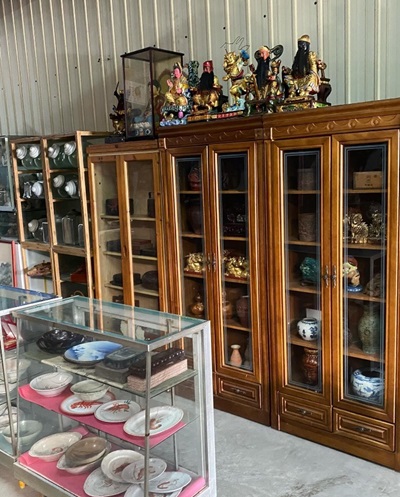中古神像收購
 中古神像收購
中古神像收購
※固定每週都有北上、南下收貨
※未退神-神尊免費不收費用幫忙處理-本人是法師
※免費住宅風水堪輿建議
※業障病(藥吃不好的病)心靈指導
李俊澄: 0932-395-867
Line ID: a0932395867
彰化縣埔鹽鄉員鹿路3段271號
中古神像收購:文化遺產的保護和保存
第一章:引言
中國是一個擁有悠久歷史和豐富文化遺產的國家。在中國的宗教信仰中,神像一直扮演著重要的角色,它們代表著各種神祇和神明,受到人們的崇拜和尊敬。然而,隨著現代社會的變遷和宗教信仰的變化,一些古老的神像可能不再受到崇拜,這就引發了中古神像的問題。為了保護這些被遺忘的神像,中古神像收購活動應運而生。本文將深入探討這一主題,探討中古神像收購的背景、重要性以及如何有助於保留和傳承中國的宗教和文化遺產。
第二章:神像在中國文化中的地位
神像在中國文化中佔據著特殊的地位。它們不僅是宗教信仰的象徵,還是藝術和文化的體現。在中國的各個宗教信仰中,都有供奉神像的傳統,這些神像代表著神明的存在,人們會前來祭拜、獻禮,以示崇敬和尊重。
神像的制作工藝也是中國藝術的一個重要方面,很多神像都具有高度的藝術價值。它們不僅在宗教場所中展示,還經常參加藝術展覽,吸引著藝術愛好者和收藏家的關注。因此,神像既是宗教物件,也是文化寶藏,具有重要的歷史和藝術價值。
第三章:中古神像的背景
中古神像是指那些因各種原因不再受到崇拜的神像。這些原因可能包括社會價值觀的改變、宗教信仰的轉變、宗教實踐的減少等等。當一個神像不再受到崇拜時,它可能被遺棄、忽視或置之不理,進一步導致其損壞和失落。
中古神像的存在不僅影響了這些神像本身,還對宗教場所和社區造成了影響。一些寺廟和宮廟可能因缺乏崇拜者而陷入經濟困難,甚至可能被迫關閉。這種情況對中國的宗教和文化遺產構成了潛在的威脅。
第四章:中古神像收購活動的興起
為了保護這些被遺忘的神像,一些個人、宗教團體、文化保護機構和博物館開始參與中古神像的收購活動。這些活動的目的是將這些神像重新引入社會,以妥善保存它們,並繼續傳承中國的宗教和文化遺產。
個人收藏家可能對中古神像感興趣,並願意支付一定價格來獲得這些文化寶藏。這種方式有助於將中古神像重新引入社會,並將其保存在適當的環境中,以便更多人欣賞。
宗教團體也可以參與中古神像的收購活動,回收這些神像並繼續祭拜崇拜,以保留宗教傳統。文化保護機構和博物館可以提供資金和支援,以幫助修復損壞的神像,並提供專業的保存和展示,以便更多人了解和欣賞這些文化寶藏。
第五章:中古神像的保存和再生
中古神像的收購活動有助於保護和保存中國的宗教和文化遺產。這些神像雖然失去了原本的宗教崇拜功能,但它們仍然具有重要的文化和藝術價值。通過這些活動,我們可以確保這些神像得到了妥善的保存,並能夠被傳承給未來的世代。
此外,中古神像的收購活動也有助於再次詮釋這些神像的意義和價值。即使不再崇拜,我們仍然可以通過學術研究、展覽和教育活動來了解這些神像的背後故事,並將它們納入中國文化的認識中。
第六章:未來展望
中古神像收購活動在保護和傳承中國文化遺產方面發揮了關鍵作用。未來,我們可以考慮擴大這一努力,提高公眾對中古神像的認識和重視。建立專門的博物館或文化遺產中心,展示這些神像的故事和藝術價值,可以有助於提高大眾對它們的理解。
同時,我們也應該加強對中古神像的研究工作,以深入了解它們的歷史、藝術和文化背景。這有助於進一步詮釋這些文化寶藏的價值,並將它們納入中國文化的主流。
第七章:結語
中古神像收購活動是一個重要的文化使命,它有助於保護和保存中國的宗教和文化遺產。這些神像雖然失去了原本的宗教崇拜功能,但它們仍然是我們文化的一部分,值得被尊重和保存。通過個人、宗教團體、文化保護機構和博物館的共同努力,我們可以確保這些神像得到妥善的保存,並傳承給未來的世代。中古神像的存在提醒我們,宗教和文化遺產不僅是過去的象徵,也是我們當下和未來的寶貴資產,值得我們共同努力來保護和傳承。
Acquisition of Medieval God Statues
Acquisition of Medieval God Statues
Acquisition of Medieval Idols: Protection and Preservation of Cultural Heritage
Chapter 1: Introduction
China is a country with a long history and rich cultural heritage. In Chinese religious beliefs, statues of gods have always played an important role. They represent various gods and deities and are worshiped and respected by people. However, with the changes in modern society and changes in religious beliefs, some ancient gods may no longer be worshiped, which raises the issue of medieval gods. In order to protect these forgotten gods, the medieval statue acquisition campaign came into being. This article will delve into this topic and explore the background, importance and how the acquisition of medieval idols can help preserve and pass on China's religious and cultural heritage.
Chapter 2: The status of divine statues in Chinese culture
Statues of gods occupy a special place in Chinese culture. They are not only symbols of religious beliefs, but also embodiments of art and culture. In various religious beliefs in China, there is a tradition of worshiping statues of gods. These statues represent the existence of gods. People come to worship and offer gifts to show reverence and respect.
The craftsmanship of making statues of gods is also an important aspect of Chinese art, and many statues of gods have high artistic value. They are not only displayed in religious places, but also often participate in art exhibitions, attracting the attention of art lovers and collectors. Therefore, statues of gods are both religious objects and cultural treasures, with important historical and artistic value.
Chapter 3: Background of Medieval Gods
Medieval idols refer to those gods that are no longer worshiped for various reasons. These reasons may include changes in social values, conversion of religious beliefs, decrease in religious practice, etc. When an idol is no longer worshiped, it may be abandoned, neglected, or left alone, further leading to its damage and loss.
The presence of medieval deities affected not only the deities themselves, but also religious sites and communities. Some temples and shrines may run into financial difficulties due to a lack of worshipers and may even be forced to close. This situation poses a potential threat to China's religious and cultural heritage.
Chapter 4: The rise of the acquisition of ancient statues of gods
In order to protect these forgotten statues of gods, some individuals, religious groups, cultural preservation institutions and museums began to participate in the acquisition of medieval statues. The purpose of these activities is to reintroduce these statues into society in order to properly preserve them and continue to pass on China's religious and cultural heritage.
Individual collectors may be interested in medieval statues of gods and be willing to pay a price to acquire these cultural treasures. This approach helps reintroduce medieval statues of gods into society and preserve them in an appropriate environment so that more people can appreciate them.
Religious groups can also participate in the acquisition of medieval statues of gods, recycle these statues and continue to worship them to preserve religious traditions. Cultural preservation agencies and museums can provide funding and support to help repair damaged idols and provide professional preservation and display so that more people can understand and appreciate these cultural treasures.
Chapter 5: Preservation and Regeneration of Medieval Gods
The acquisition of medieval statues helps protect and preserve China's religious and cultural heritage. Although these statues have lost their original religious worship functions, they still have important cultural and artistic value. Through these activities, we can ensure that these idols are properly preserved and can be passed on to future generations.
In addition, the acquisition of medieval statues of gods also helps to reinterpret the meaning and value of these statues. Even if we no longer worship them, we can still understand the stories behind these statues through academic research, exhibitions, and educational activities and incorporate them into our understanding of Chinese culture.
Chapter Six: Future Outlook
The acquisition of medieval statues plays a key role in protecting and inheriting Chinese cultural heritage. In the future, we could consider expanding this effort to increase public awareness and appreciation of medieval gods. Establishing dedicated museums or cultural heritage centers to showcase the stories and artistic value of these deities can help improve public understanding of them.
At the same time, we should also strengthen our research on medieval gods to gain a deeper understanding of their historical, artistic and cultural backgrounds. This helps to further interpret the value of these cultural treasures and integrate them into the mainstream of Chinese culture.
Chapter 7: Conclusion
The acquisition of medieval statues is an important cultural mission that helps protect and preserve China's religious and cultural heritage. Although these statues have lost their original religious worship functions, they are still part of our culture and deserve to be respected and preserved. Through the combined efforts of individuals, religious groups, cultural conservation institutions and museums, we can ensure that these images of deities are properly preserved and passed on to future generations. The existence of medieval statues reminds us that religious and cultural heritage are not only symbols of the past, but also valuable assets of our present and future, worthy of our joint efforts to protect and inherit.